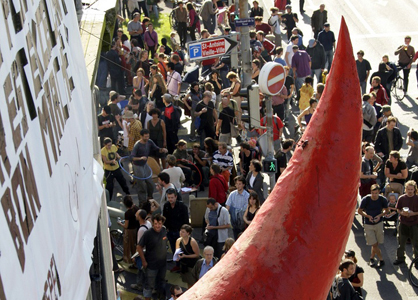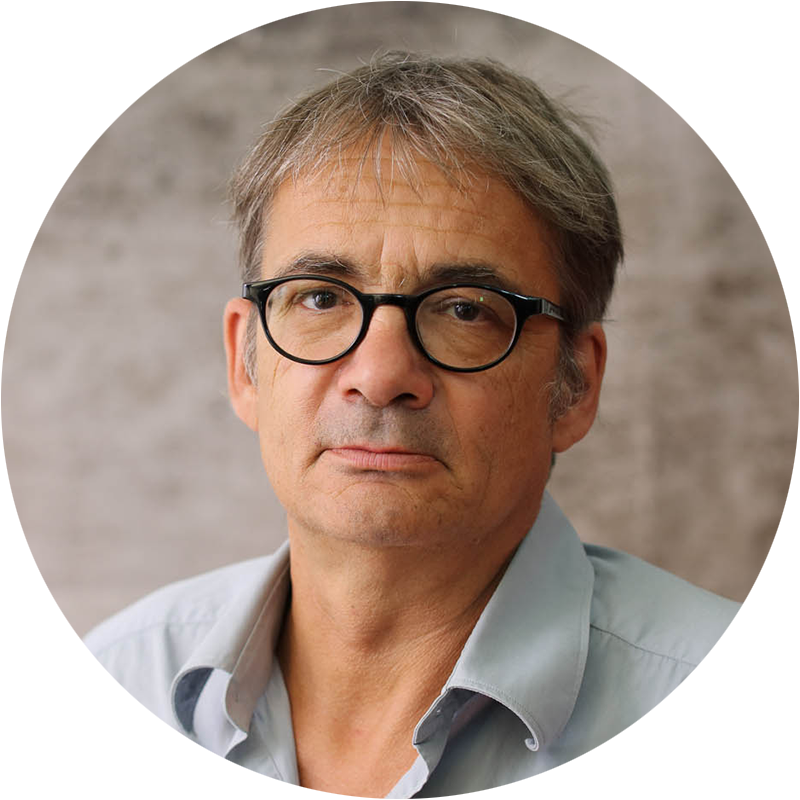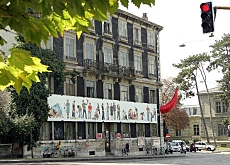End of the road for Geneva’s squats?

The inhabitants of Geneva's oldest and most famous squat, Rhino, expect to be evicted soon.
It will end nearly 20 years of Rhino, which was set up to promote communal housing in the city where there has long been a shortage of accommodation.
The proprietor of the building and the lawyer for the squatters put their cases to a magistrate earlier this week.
The looming eviction also spells the end for Geneva’s liberal attitude to squats. Since the 1980s the authorities had tolerated the takeover of unoccupied buildings. As far as its squats were concerned, Geneva was unique not only in Switzerland but even in Europe.
Luca Pattaroni, of the Federal Institute of Technology in Lausanne, spoke to swissinfo about the squat movement.
swissinfo: Are we going to see an end to squats in Geneva?
Luca Pattaroni: Without political support, the movement is likely to disappear. But it might re-emerge in different forms – for example in cultural activities.
swissinfo: Do squats exist in other Swiss cities?
L.P.: There are squats in cities like Zurich, Basel, Lausanne and Fribourg. But even at the height of the movement in the 1980s there were never more than ten in any of those places. Geneva is an exception, since during the 1990s it had up to 160 buildings taken over by squatters.
swissinfo: How are the squats in Geneva different from the others?
L.P.: The local authorities had a policy of limited toleration, which encouraged the development of squats from the 1980s onwards. They allowed empty blocks of flats in the city and the canton to be occupied, giving the squatters contracts of trust, and they suspended the clearance of buildings that had been taken over, whether they were privately or publicly owned.
This tolerance was the consequence of the political battles of the 70s when plans to transform certain areas of the city met with a lot of resistance because people felt they were heartless and took no account of the people who actually lived there.
swissinfo: So the squats are basically political?
L.P.: The movement sprang up throughout the city as a response to property speculation. The resistance was widely supported by the public and by the left-wing parties, which made it possible to legitimise what was in point of law an illegal action.
This legal basis and political legitimacy is what Geneva’s squat movement has now lost.
swissinfo: But the movement has taken other forms too?
L.P.: In comparison with the Zurich squats, which are very militant, the ones in Geneva are very diverse.
You can distinguish between three types : the refuge, for people on the edge of society and those without papers ; the politicised squat close to Trotskyist or anarchist circles which oppose private property ; and the cultural squat which has led to the emergence of a vibrant artistic scene – theatre, concerts, bars, galleries. For example, Omar Porras’ Teatro Malandro, which now has a Europe-wide reputation, came out of these squats.
swissinfo: And who are the squatters?
L.P.: Originally most of them were students from the post-68 left, plus some apprentices. Later they were joined by immigrants from Latin America and Central Europe.
There were also children from wealthier families. But research shows that most squatters were, and are, people of low income, from a wide range of social backgrounds.
swissinfo: How do you see the future of squats in Geneva and in Switzerland as a whole?
L.P.: What is at issue is the right to housing versus the right to property. The squatters are also demanding that different lifestyles and different kinds of residence should be tolerated.
This problem also concerns tenants who, in Switzerland, do not dare have their say about what is done with their homes. And the squat movement is one example of citizens taking a more active part in city politics.
What is actually likely to happen is that they will develop into housing cooperatives, since these also enjoy the approval of right wing deputies. They are already very well established in German-speaking Switzerland – they account for 18 per cent of housing in Zurich. They give the people who live in them a say about the design of the building and how it should work, including elements of communal life.
swissinfo-interview: Frédéric Burnand in Geneva
The movement to occupy empty buildings which started in Geneva in the 1970s was part of a trend in cities all over the western world – New York, London, Berlin, Amsterdam, and Copenhagen. Squatters wanted to create an alternative lifestyle.
Geneva had nearly 160 buildings and more than 2,000 squatters at the height of the movement in the middle of the 1990s. It now has only 27.

In compliance with the JTI standards
More: SWI swissinfo.ch certified by the Journalism Trust Initiative


You can find an overview of ongoing debates with our journalists here. Please join us!
If you want to start a conversation about a topic raised in this article or want to report factual errors, email us at english@swissinfo.ch.